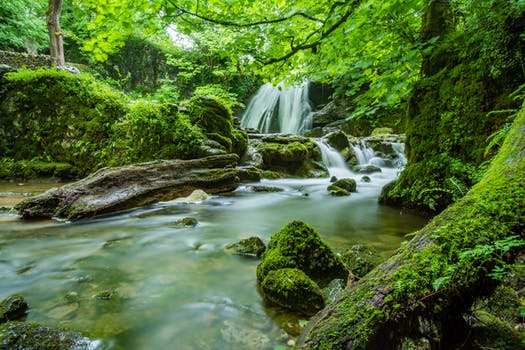The Benefits of Forest Bathing
Category: Healthy World

I spent a wonderful spring day with family recently walking along a slow-moving river, a slight breeze blowing through our hair, the sounds of birds nearby, a blue sky filled with fluffy white clouds ~ it was incredibly peaceful. I thought about how relaxed I was, unconcerned about worldly events, free of the noise of everyday thoughts that can often be stressful, and so grateful to be aware of all the gifts nature was giving us. Although somewhat brief, it was enough. It made me realize how important those moments are to our mental state and particularly our health.
Japan calls this Shinrin-yoku, a term that means “taking in the forest atmosphere” or “forest bathing.” It was developed in Japan during the 1980s and has become a cornerstone of preventive health care and healing in Japanese medicine. Researchers in Japan and South Korea have discovered that in just 15 minutes of forest bathing blood pressure drops, stress levels are reduced and concentration and mental clarity improve. I can definitely attest to this after my recent spring walk.
I was happy to learn that “forest bathing” is becoming popular now in the U.S. (particularly in California) just as yoga and meditation emerged 30 years ago…an important fact since in 2001, a survey sponsored by the U.S. Environmental Protection Agency found that, on average, Americans spend 87 percent of their time indoors and 6 percent in an enclosed vehicle. With the knowledge that spending outdoors with mindfulness can actually improve our health, it makes me want to participate more in “forest bathing.” When I see hikers trekking up a mountain, my first thought is that I would never be able to do that; however, just spending time in that same place, with my only intent is to breathe deep, take small steps and enjoy the space, is very inviting and sounds much more relaxing to me than “roughing it” in the woods.
Ben Page, a certified forest therapy guide who founded Shinrin Yoku, Los Angeles, states, “So whereas a nature walk’s objective is to provide informational content and a hike’s is to reach a destination, a Shinrin-yoku walk’s objective is to give participants an opportunity to slow down, appreciate things that can only be seen or heard when one is moving slowly, and take a break from the stress of their daily lives.”
But what if you are not near that beautiful forest? Can you have the same experience without it? According to the Association of Nature and Forest Therapy, forest bathing “is a research-based framework for supporting healing and wellness through immersion in forests and other natural environments.” That last “and” is important; the forest itself might not be necessary. Good to know! My husband and I walk each day, Shinrin-yoku style, not in a lovely forest, but in a lovely small town environment, surrounded by cars, office buildings, etc. However, I take my time enjoying the warmth of the day, the flowers growing in various containers outside the businesses, the fresh air. When we pick up our mail at our apartment complex we each get a cup of tea and sit on wooden rocking chairs overlooking the apartment pool.\ and beautiful grounds. The water is sparkling and inviting and just the sounds of the birds in the nearby trees help me to appreciate the moment.
What about you? Are you setting apart special times that you can be mindful of where you are and what you are doing? The health benefits are many and the only side effects are less stress and peace of mind! I would love to hear about your own experiences with “forest bathing.”
“Between every two pine trees is a doorway leading to a new way of life.”
John Muir



Facebook Comments